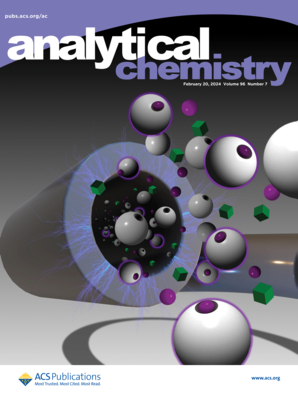Target-Triggered Cascaded Self-Feedback DNAzyme Circuit Loaded in ZIF-8 for Highly Sensitive miRNA Imaging in Living Cells
IF 6.7
1区 化学
Q1 CHEMISTRY, ANALYTICAL
引用次数: 0
Abstract
The highly sensitive and rapid imaging of miRNA in living cells promises to advance our understanding of diseases and promote their diagnosis and treatment. To enhance the sensitivity of miRNA imaging, a series of cascade signal amplification strategies based on enzyme-free methods have been developed. However, these cascaded amplification strategies involve complex designs and multiple amplification mechanisms, leading to potential side effects. Herein, we have developed a novel hairpins@ZIF-8 nanosystem by rationally integrating ZIF-8 with a cascaded self-feedback DNAzyme circuit (CSDC), achieving highly sensitive and rapid imaging of miRNA in living cells. ZIF-8 facilitates the efficient transfection of nucleic acid probes into cells and provides the necessary cofactor ions for CSDC. The developed CSDC possesses exponential amplification based solely on the DNAzyme mechanism. Benefiting from the exponential amplification efficiency, the CSDC exhibited higher sensitivity than traditional DNAzyme-based amplification, with a detection limit of 2.28 fM, approximately 105 times more sensitive than traditional DNAzyme-based amplification. This hairpins@ZIF-8 nanosystem demonstrated strong practical application capabilities, effectively reflecting fluctuations in intracellular miRNA levels and successfully distinguishing between normal and tumor cells based on miRNA expression differences. It could also be applied for in vivo miRNA imaging. This proposed strategy is anticipated to pave the way for innovative amplification approaches and serve as a vital instrument in miRNA-related research, diagnosis, and treatment.

求助全文
约1分钟内获得全文
求助全文
来源期刊

Analytical Chemistry
化学-分析化学
CiteScore
12.10
自引率
12.20%
发文量
1949
审稿时长
1.4 months
期刊介绍:
Analytical Chemistry, a peer-reviewed research journal, focuses on disseminating new and original knowledge across all branches of analytical chemistry. Fundamental articles may explore general principles of chemical measurement science and need not directly address existing or potential analytical methodology. They can be entirely theoretical or report experimental results. Contributions may cover various phases of analytical operations, including sampling, bioanalysis, electrochemistry, mass spectrometry, microscale and nanoscale systems, environmental analysis, separations, spectroscopy, chemical reactions and selectivity, instrumentation, imaging, surface analysis, and data processing. Papers discussing known analytical methods should present a significant, original application of the method, a notable improvement, or results on an important analyte.
 求助内容:
求助内容: 应助结果提醒方式:
应助结果提醒方式:


